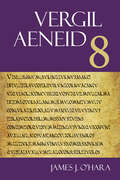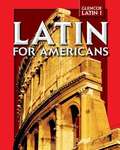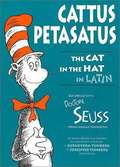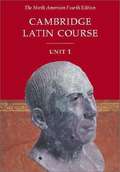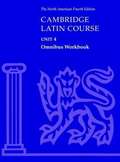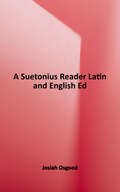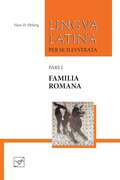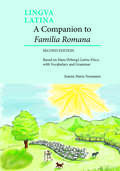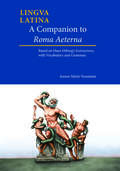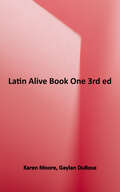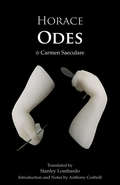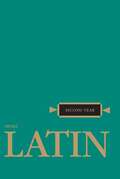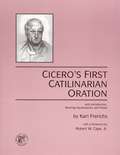- Table View
- List View
Aeneid 8 (The Focus Vergil Aeneid Commentaries)
by Vergil Mr James J. O'Hara Randall GanibanVergil: Aeneid 8 is part of a new series of commentaries on the Aeneid. Each volume adapts with extensive revisions and additions the commentaries of T. E. Page (1884, 1900), and is edited by a scholar of Roman epic. The present volume offers the Latin text of Book 8 along with maps, extensive notes, and commentary designed to meet the needs of intermediate students of Latin. A two-volume edition of the entire Aeneid designed to meet the needs of advanced students will be derived from the series.
Cattus Petasatus: The Cat in the Hat in Latin
by Jennifer Morrish Tunberg Terence Tunberg SeussIncludes a Latin-English glossary and a note on the verse form and rhythm.
Cambridge Latin Course, Unit 1
by Stephanie M. Pope Patricia E. Bell Stan Farrow Anne Shaw Randy Thompson Joy Mellor Leslie Jones Peter Kesteven Neil SuttonThe Fourth Edition Cambridge Latin Course is an introductory program organized into four well-integrated units. Cambridge's proven approach includes a stimulating continuous story line, interwoven grammatical development and cultural information, supportive illustrations and photographs, and a complete Language Information section. Reading is the heart of the Cambridge Latin Course, and all the elements of the program - illustrations, vocabulary, grammar and syntax, cultural contexts and references, activities - are carefully introduced and arranged to provide students with the skills they need to read with comprehension and enjoyment from the very first page.
Cambridge Latin Course, Unit 4, Omnibus Workbook
by Stephanie M. Pope Patricia E. Bell Stan Farrow Richard M. Popeck Anne Shaw Joy Mellor Leslie Jones Peter Kesteven Neil SuttonThe North American Cambridge Latin Course is a well-established four-part Latin program whose approach combines a stimulating, continuous storyline with grammatical development, work on derivatives, and cultural information. There is also a complete Language Information section, plus numerous color photographs illustrating life in the Roman world. The Course has now been fully revised and updated in light of feedback from user schools, and includes the very best in new research. The Fourth Edition continues to offer teachers and students alike a stimulating, reading-based approach to the study of Latin. The Omnibus Workbook is designed to be used in conjunction with the Unit 4 Student's Text. A variety of exercises is provided for each Stage.
A Suetonius Reader: Selections From the Lives of the Caesars and the Life of Horace
by Josiah OsgoodThe popular appeal of Suetonius' Lives of the Caesars is obvious. Who would not thrill reading about the great Julius Caesar's delight in the Senates bestowal of the right to wear a laurel wreath on all occasions because it covered his baldness? Or that the Divine Augustus had rotten teeth and wore special platform shoes to make himself look taller? <p><p>Suetonius, however, has not always been as enthusiastically received among historians, who sometimes overlook that he intended his work as biography, not history, or that he patently aimed for prose that was not literary, but instead unadorned, clear, and concise. Such qualities of prose, however, happily make his Latin enjoyable both to teach and to read. And while Suetonius' details of the weird worlds of extraordinary men are endlessly entertaining, they are not merely that. This business like biographer produced an extraordinarily influential work. His Caesars is a landmark in the history of biographical writing, and remains a key source for the history of Rome, its transition from Republic to Empire, and contemporary efforts to come to terms with individual destiny, through astrology, physiognomy, dream analysis, and more. Through to the present day Suetonius has profoundly shaped modern perceptions of Roman society.
Familia Romana (Lingua Latina #Book One)
by Hans H. ØrbergHans Ørberg's Lingua Latina per se Illustrata is the world's premiere series for learning Latin via the Natural Method. The Natural Method encourages students to learn Latin without resorting to translation, but instead by teaching them to think in the language: students first learn grammar and vocabulary inductively through extended contextual reading and an ingenious system of marginal notes. Lingua Latina per se Illustrata is also the most popular series for those teachers at both the secondary and collegiate levels who wish to develop Latin conversational skills in the classroom. <p><p>Familia Romana (the main book of Pars I of the Lingua Latina per se illustrata series) contains thirty-five chapters and describes the life of a Roman family in the 2nd century A.D. It culminates in readings from classical poets and Donatus's Ars Grammatica, the standard Latin school text for a millennium. Each chapter is divided into two or three lessons (lectiones) of a few pages each followed by a grammar section (Grammatica Latina) and three exercises (Pensa). Hans Ørberg's impeccable Latin, humorous stories, and the Peer Lauritzen illustrations, reproduced in full color, make this work a classic. The book also includes a table of declensions, a Roman calendar, and a word index (index vocabulorum). <p><p>The Lingua Latina series incorporates the following features: <p><p>The most comprehensive treatment of Latin grammar available in an elementary textbook. <p><p>A vocabulary of almost 1,800 words, reinforced by constant and creatively phrased repetition, vastly expands the potential for later sight reading. <p><p>A complete line of ancillary volumes, exercises, and readers both in print and online.
A Companion to Familia Romana: Based on Hans Ørberg's Latine Disco, with Vocabulary and Grammar
by Jeanne Neumann Hans H. ØrbergThis volume is the completely reset Second Edition of Jeanne Marie Neumann's A College Companion (Focus, 2008). It offers a running exposition, in English, of the Latin grammar covered in Hans H. Ørberg's Familia Romana, and includes the complete text of the Ørberg ancillaries Grammatica Latina and Latin–English Vocabulary. It also serves as a substitute for Ørberg's Latine Disco, on which it is based. As it includes no exercises, however, it is not a substitute for the Ørberg ancillary Exercitia Latina I. Though designed especially for those approaching Familia Romana at an accelerated pace, this volume will be useful to anyone seeking an explicit layout of Familia Romana's inductively-presented grammar. In addition to many revisions of the text, the Second Edition also includes new units on cultural context, tied to the narrative content of the chapter.
A Companion to Roma Aeterna: Based on Hans Ørberg's Instructions, with Vocabulary and Grammar
by Jeanne Neumann Hans H. ØrbergA sequel to her widely used A Companion to Familia Romana (now in its second edition), Jeanne Marie Neumann's A Companion to Roma Aeterna offers a running commentary, in English, of the Latin grammar covered in Hans H. Ørberg's Roma Aeterna, and includes the complete text of the Ørberg ancillaries Grammatica Latina and Latin–English Vocabulary II. It also serves as a substitute for Ørberg’s Instructions, on which it is based. Though designed especially for those approaching Roma Aeterna at an accelerated pace, this volume will be useful to anyone seeking an explicit exposition of that volume's implicitly presented grammar. In addition to many revisions of the text, A Companion to Roma Aeterna also includes new units on cultural context, tied to the narrative content of the chapter.
Caesar: Selections From His Commentarii De Bello Gallico
by Hans-Friedrich Mueller Julius Caesar Donald E. Sprague Bridget S. DeanNIMAC-sourced textbook
Latin Alive! (Latin Alive Series #Book One)
by Karen Moore Gaylan DuBoseStudents will be delighted by what they learn in each new chapter of Latin Alive!, Book One, and they will learn to see that Latin is everywhere around them. As the first text in a three-year series, it is a rigorous and thorough introduction to this great language and is designed to engage upper school (middle and high school) student. Brimming with relevant facts and stories this text offers something for everyone. A Teacher’s Edition including answer keys, teacher’s helps and additional activities is available separately.
Winnie Ille Pu
by Alexander Lenard A. A. Milne"... diem cum Pu ac Porcellus heffalumpum capere conati sunt ..." "Non ceperunt, ceperuntne?" "Minime vero." Tu nequivit, quia omnis cerebri expers est. Ego autem heffalumpum cepi?" "Vere, istud pars fabulae est." Christophorus Robinus adnuit: "Egomet reminiscor," dixit. "Sed eae res fugiunt Pui memoriam, qua de causa fabulas bis narratas diligit. Tum tamen fabula vera est, non solum opus memoriae." "Equidem non secus sentio," dixi. Christophorus Robinus suspirium ab imo duxit, ursum pede apprehendit et Pum post se trahens ad ostium iit. Apud ostium se convertens dixit: "Venisne ut me in balneo videas?" "Possum," dixi. "Num eum ictu laesi?" "Minime vero." Adnuit et exiit et interposito deinde brevi tempore audivi Winnie ille Pum BUMP-BUMP-BUMP gradibus post eum ascendere.
A Song of War: Readings from Vergil's Aeneid
by Richard A. Lafleur Alexander G. MckayNIMAC-sourced textbook
Ovid: Amores, Metamorphoses Selection
by Charbra Adams Jestin Phyllis B. Katz Ovid Bridget Dean Laurie Haight Keenan Laurel DraperNIMAC-sourced textbook
Odes: With Carmen Saeculare
by HoraceHorace's Odes enjoys a long tradition of translation into English, most famously in versions that seek to replicate the quantitative rhythms of the Latin verse in rhymed quatrains. Stanley Lombardo, one of our preeminent translators of classical literature, now gives us a Horace for our own day that focuses on the dynamics, sense, and tone of the Odes, while still respecting its architectonic qualities.In addition to notes on each of the odes, Anthony Corbeill offers an Introduction that sketches the poet's tumultuous political and literary careers, highlights the Odes' intricate construction and thematic breadth, and identifies some qualities of this work that shed light on a disputed question in its reception: Are these poems or lyrics?This dual-language edition will prove a boon to students of classical civilization, Roman literature, and lovers of one of the great masters of Latin verse. The Amazon Kindle and other flowing-text eBook editions include the text of the Latin originals at the end of the book and the line numbers are enclosed in square brackets and embedded at the end of lines.
Second Year Latin
by Robert J. HenleThe backbone of Henle Latin Second Year is intensive language study, including review of the first year plus new materials. Separated into four parts, Henle Latin Second Year includes readings from Caesar's Commentaries, extensive exercises, and Latin-English vocabularies. Humanistic insight and linguistic training are the goals of the Henle Latin Series from Loyola Press, an integrated four-year Latin course. Time-tested and teacher endorsed, this comprehensive program is designed to lead the student systematcially through the fundamentals of the language itself and on to an appreciation of selected classic texts.
Cicero's First Catilinarian Oration with Introduction, Running Vocabularies, and Notes
by Karl Frerichs Marcus Tullius Cicero Laurie Haight KeenanCicero's First Catilinarian speech is now available in a practical and inexpensive annotated edition for third-year Latin students. In light of existing textbooks, Karl Frerichs' edition has several important and distinguishing strengths: -- Clear, tripartite page layout for text, vocabulary and notes on facing pages-- Running vocabulary separate from notes and complete vocabulary at the end-- Introduction and Glossary of Terms and Figures of Speech provide basic biographical, historical, and rhetorical background-- Maps and illustrations

